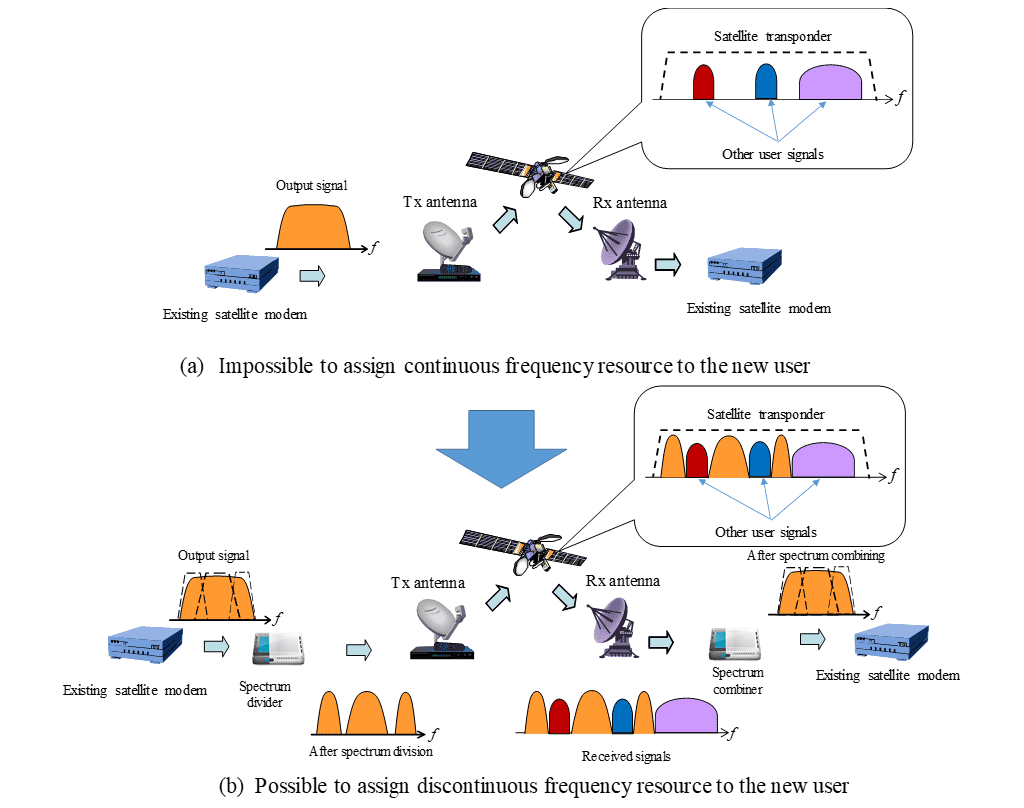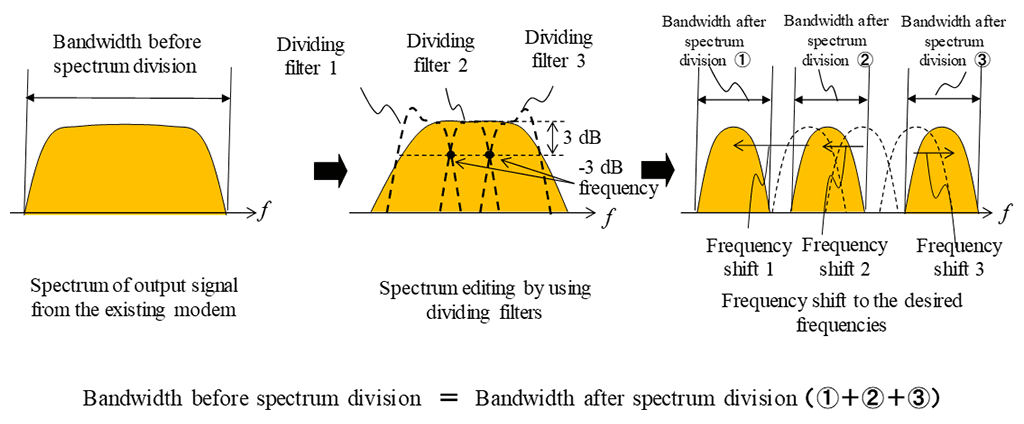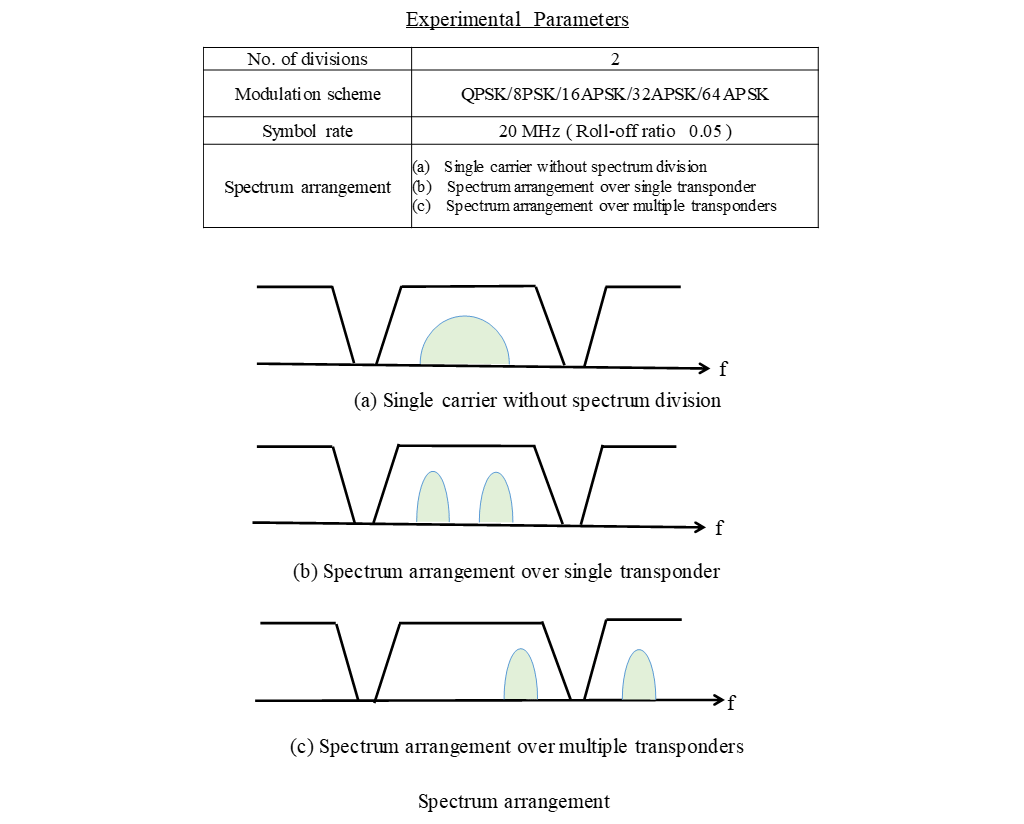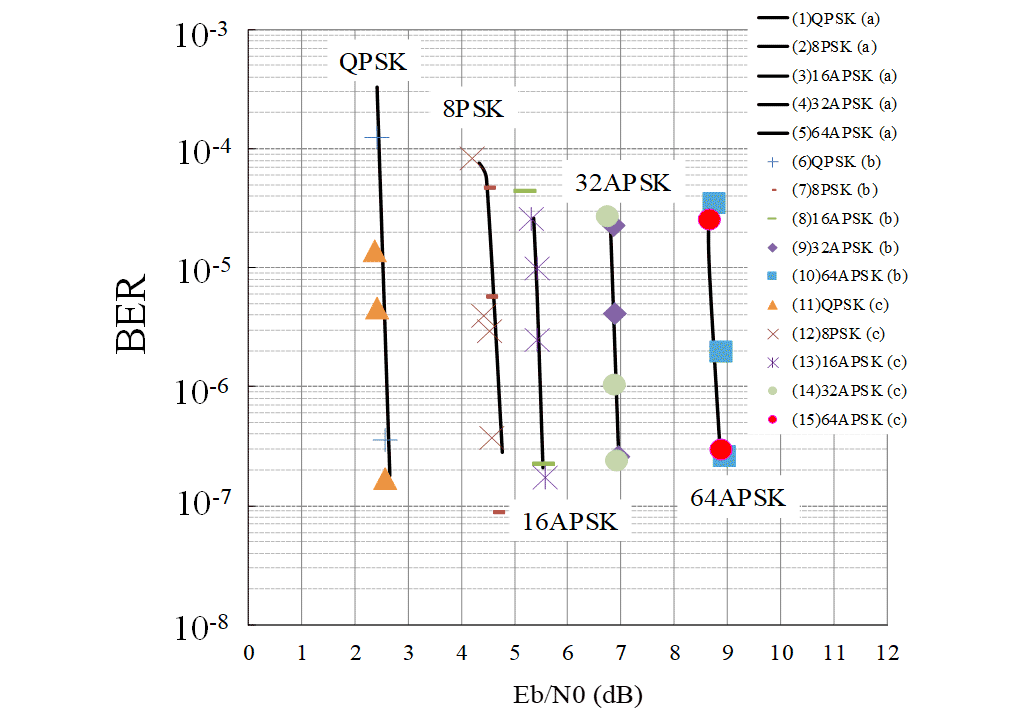Microsoft ends support for Internet Explorer on June 16, 2022.
We recommend using one of the browsers listed below.
- Microsoft Edge(Latest version)
- Mozilla Firefox(Latest version)
- Google Chrome(Latest version)
- Apple Safari(Latest version)
Please contact your browser provider for download and installation instructions.
December 11, 2019
Nippon Telegraph and Telephone Corporation
Experimental verification on Direct Spectrum Division Transmission that divides up and recombines spectrum of wireless signal transmitted to satellite
~For efficient use of satellite transponders and more secure communications~
Nippon Telegraph and Telephone Corporation (H.Q.: Chiyoda-ku, Tokyo, President and CEO: Jun Sawada) has developed a technique named Direct Spectrum Division Transmission (DSDT) that divides the spectrum of the satellite communications signals into multiple sub-spectra, then makes communications after allocating them to the unused frequency slots of the operating band of the transponder*1 in space, and finally recombines the divided sub-spectra into a single carrier signal. The practicality of this technique was verified by satellite experiments.
Simply by attaching a “DSDT adapter” to the existing satellite modem*2, the spectrum of the signal can be divided up and recombined, so that unused frequency resources scattered throughout the operating band of the transponder can be used without affecting existing signals of other users that share the same transponder. In addition, this technique enhances communication security by dividing the signal into multiple sub-spectra in the transmitter and combining the multiple sub-spectra back into the original signal in the receiver.
We conducted satellite experiments on a preproduction prototype showing that the proposed technique is a practical way of exploiting unused frequency resources scattered on the satellite transponder. Hereafter, we will study an effective method of allocating unused frequency resources to multiple users that share the same transponder and further improve spectral efficiency of satellite transponders.
Background
It is important for satellite communications to use the limited frequency resources of the transponder efficiently so that they can be shared by as many users as possible. Because each user acquires and releases the desired frequency resource repeatedly, there are many cases in which unused frequency resources become scattered throughout the operating band of the transponder.
In particular, if a new user requires high-speed communications, it is sometimes difficult to find consecutive frequency resources in the transponder. Up to now, this situation has usually meant that a satellite operator must ask the existing users sharing the same transponder to stop their communications and transfer them to other frequencies. However, stopping user communications and changing their frequencies is inconvenient for customers and increases the work of the satellite operator.
Research output
NTT Access Network Service Systems Laboratories has developed a technique, named Direct Spectrum Division Transmission (DSDT) that divides up the spectrum output from the existing modem into multiple sub-spectra, allocates the sub-spectra to the desired frequencies, and finally combines them to regenerate the original signal. This technique achieves high-speed communications by bundling unused frequency resources on the transponder without reassigning frequency resources. This enables the frequency resources to be flexibly assigned to each user. As a result, it is expected to be improve user convenience. This technique is expected to enable more efficient deployment of satellite communications, not only in usual but also in times when satellite communications are urgently needed because of disaster or some unusual situations. In addition, since this technique divides the spectrum of the signal on the physical layer and arranges the information it carries in a dispersed fashion in the satellite transponder, it becomes difficult for other users to intercept the information. This means that this technique can also enhance the security of communications. We conducted satellite-based experiments showing the proposed technique can divide up the signal output from ordinary existing satellite modems into multiple sub-spectra and allocate and re-combine them.
Technical points
1.Spectrum dividing and combining technique
Figure 1 shows the concept of the spectrum dividing and combining technique. An analogue signal output from the satellite modem is fed to the transmission (Tx) DSDT adapter and digitalized. After that, its spectrum is divided by special filter banks*3 into multiple sub-spectra. Then, these sub-spectra are allocated to the desired frequencies. The sub-spectra are finally converted back into an analogue signal, which is the transmitted towards the satellite through the Tx antenna RF unit.
After the receiver, the received analogue signal from the satellite arrives signal is digitalized and the sub-spectra at the desired frequencies are extracted. Then, the frequencies of the extracted sub-spectra are converted and combined. The combined spectrum is again converted into an analogue signal and passed to the existing receiver (Rx) satellite modem, which receives the analogue signal as usual. Thus, it can demodulate the signal without having to recognize that the spectrum of the signal had been divided up and combined again for propagation. In other words, this technique can divide and combine signals without having to recognize the signal format used by the satellite modem.
(1) Spectrum editing technique
If the spectrum of the signal is divided into multiple sub-spectra and these sub-spectra are arranged in the satellite transponder, the transition bandwidth of the sub-spectra increases in proportion the number of spectrum divisions. This increases the total bandwidth after spectrum division and degrades spectral efficiency. To tackle this problem, we introduce a spectrum editing technique that edits the frequency response of each sub-spectrum and narrows its occupied bandwidth (see Figure 2). This technique enables the same bandwidth to be kept before and after spectrum division and the discontinuous frequency resources to be used with the same spectral efficiency.
(2) Spectrum synchronous combining technique
Figure 3 shows the spectrum synchronous combining technique. In combining multiple sub-spectra, the spectrum synchronous combining technology used in the receiver to regenerate the original signal includes methods for phase synchronization, frequency offset compensation, and gain control among the sub-spectra. If the spectral power density differs among the sub-spectra, the signal quality of combined spectrum deteriorates. Thus, an auto-gain-control function is implemented that adjusts the spectral density of the sub-spectra before spectrum combining. An auto frequency control is also implemented, since a frequency offset causes the Rx filter banks to decrease the received signal power. In addition, a phase synchronization technique that makes the phase of transition bands of sub-spectra to be continuous is implemented.
2.Satellite experiments
To confirm the practicality of this technique, we carried out satellite experiments by using an overseas commercial satellite modem as the existing modem. Figure 4 shows examples of the spectrum into which the Tx signal was divided. We confirmed that the spectra of the QPSK signal with roll-off ratios 0.1 and 0.05 could be flexibly divided and the multiple sub-spectra could be allocated to the desired frequencies. We compared the BERs*4 with/without spectrum division. Figure 5 shows the parameters, and Figure 6 shows the BERs, wherein it is clear that the performances without spectrum division (a), with spectrum division over the same transponder (b), and with spectrum division over multiple transponders (c) are the same. This means the proposed spectrum division and combining technique is practical.
Future work
The satellite experiments confirmed that the proposed technique can flexibly divide up and recombine the spectrum of a signal output from an existing satellite modem. This means the technique is effective and practical. The technique mainly consists of digital signal processing software implementable on an FPGA*5. Therefore, it will be also possible to implement it on FPGAs embedded in commercial satellite modems, as intellectual property. Hereafter, we will study a spectrum allocation method using this technique.
Acknowledgements
This work is related to research sponsored by the Ministry of Internal Affairs and Communications through grants for “Research and Development on Dynamic Polarization and Frequency Control Technologies for High-Capacity Satellite Communications.” The RF facilities that were used in the satellite experiments are operated by SKY Perfect JSAT Corporation.
Glossary
*1A relay node in space that receives the wireless signal from an earth station and transmits it again to the Earth after amplifying it, converting its frequency, and so forth.
*2A piece of hardware equipped with a function that modulates information and generates a Tx signal, as well as a function that demodulates the received signal and extracts the information.
*3A band-pass filter array technique in which a signal is decomposed into multiple sub-band signals and/or the multiple sub-band signals are combined to one signal.
*4Bit error ratio: for example, if 1 bit error occurs while transmitting 100 bits, the BER is 0.01.
*5A field-programmable gate array (FPGA) is an integrated circuit designed to be configured by a customer or a designer after manufacture
Attachments
 Fig. 1 Concept of spectrum division and combining
Fig. 1 Concept of spectrum division and combining
 Fig. 2 Spectrum editing technique
Fig. 2 Spectrum editing technique
 Fig. 3 Spectrum synchronous combining technique
Fig. 3 Spectrum synchronous combining technique
 Fig. 4 Examples of spectrum division
Fig. 4 Examples of spectrum division
 Fig. 5 Experimental parameters
Fig. 5 Experimental parameters
 Fig. 6 BERs in satellite experiments
Fig. 6 BERs in satellite experiments
Inquiries regarding this matter
Nippon Telegraph and Telephone Corporation
Information Network Laboratory Group, Public Relations
Email:inlg-pr-pb-ml@hco.ntt.co.jp
Information is current as of the date of issue of the individual press release.
Please be advised that information may be outdated after that point.
NTT STORY
WEB media that thinks about the future with NTT










